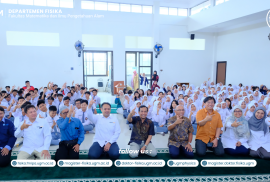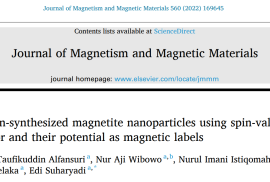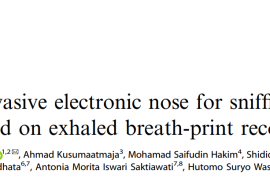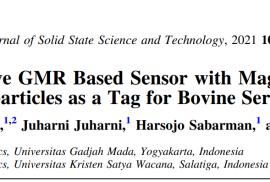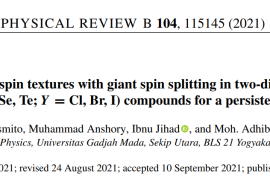[vc_row][vc_column][vc_column_text]Kelompok Bidang Keahlian (KBK) Fisika Material dan Instrumentasi, Departemen Fisika FMIPA Universitas Gadjah Mada kembali melaksanakan kegiatan Pengabdian kepada Masyarakat (PKM) pada Senin, 14 Juli 2025, di SMA Negeri 8 Yogyakarta. Kegiatan ini mengangkat tema Tahun Internasional Sains dan Teknologi Kuantum: Membangun Masa Depan Karier dan Finansial dengan Fisika dan dihadiri oleh sekitar 270 siswa kelas 11.
Acara PKM dibagi menjadi dua sesi kegiatan. Sesi pertama diawali dengan sambutan dari Ketua Departemen Fisika UGM, Prof. Dr.Eng. Edi Suharyadi, M.Eng., yang memperkenalkan Departemen Fisika UGM secara umum, mulai dari program studi, kegiatan penelitian, hingga peluang karier lulusan fisika. Untuk menyemarakkan suasana, para siswa diajak bermain games interaktif melalui platform Kahoot dengan pertanyaan seputar fisika dasar. Sesi ini disambut antusias oleh siswa-siswi SMA N 8 Yogyakarta yang bersemangat menjawab dan bersaing dalam suasana yang edukatif dan menyenangkan.
Selanjutnya, sesi talkshow menjadi inti dari kegiatan PKM kali ini, dipandu oleh moderator Dr.Sc. Ari Dwi Nugraheni, S.Si., M.Si. Narasumber utama, Prof. Dr.Eng. Kuwat Triyana, M.Si., memaparkan tentang pentingnya jiwa entrepreneur di bidang fisika dan membahas peluang kerja lulusan fisika, termasuk kesempatan berkarier di bidang semikonduktor di Taiwan. Beliau juga menyinggung program Fisika Industri yang ada di Departemen Fisika UGM, di mana mahasiswa dibekali kuliah berbasis industri dan diterjunkan langsung ke lapangan sebagai bentuk implementasi nyata ilmu fisika.
Dalam sesi lanjutan, Prof. Dr.Eng. Yusril Yusuf, S.Si., M.Si., M.Eng. menyampaikan informasi terkait fasilitas penelitian dan jejaring kerja sama internasional Departemen Fisika UGM. Kemudian, Dr.Eng. Ahmad Kusumaatmaja, S.Si., M.Sc. memberikan penjelasan mengenai Program Studi Fisika dan pengenalan Program International Undergraduate Program (IUP) Fisika. Sesi dilanjutkan dengan pemaparan dari Moh. Adhib Ulil Absor, S.Si., M.Sc., Ph.D., yang menyampaikan penjelasan menarik tentang bagaimana konsep kuantum bekerja dalam kehidupan sehari-hari.
Antusiasme peserta semakin terlihat dalam sesi tanya jawab. Salah satu siswa bertanya mengenai perbedaan antara jurusan MIPA dan Teknik, yang dijawab secara komprehensif oleh para narasumber, memberikan pemahaman yang lebih dalam tentang prospek dan keunikan masing-masing bidang.
Kegiatan PKM ini menjadi wujud nyata kontribusi Departemen Fisika UGM dalam mendekatkan dunia pendidikan tinggi kepada siswa sekolah menengah serta membuka wawasan tentang pentingnya sains fisika dalam membangun masa depan karier dan finansial di era teknologi kuantum.[/vc_column_text][/vc_column][/vc_row][vc_row][vc_column width=”1/2″][vc_gallery type=”flexslider_slide” interval=”3″ images=”15098,15097,15096,15095,15094″ img_size=”1040×580″ onclick=”img_link_large” css=”” title=”Dokumentasi Kegiatan”][/vc_column][vc_column width=”1/2″][vc_gallery type=”flexslider_slide” interval=”3″ images=”15093,15092,15091,15090,15089″ img_size=”1040×580″ onclick=”img_link_large” css=”” title=”PKM SMAN 8 Yogyakarta”][/vc_column][/vc_row]

